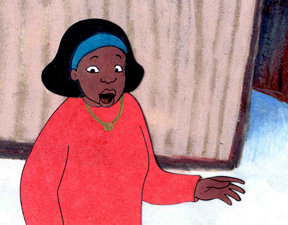Animation &Books &SpornFilms 10 Jan 2006 08:51 am
Kitson Book & Champagne
Ramblings too:
As I started to express in yesterday’s comments, Clare Kitson’s book on Tale of Tales has had me thinking a lot about storyboards. I must say my studio has a unique way in dealing with storyboards in that there is no unique way in dealing with them. All aspects of the film are organic; the film continues to grow and develop until it’s completed. Since mine is a small studio, I can easily oversee any aspect I want. Since I have a large part in the animation, I can even alter things at that phase. I also work with animators I trust, and I like to give those animators a large say in what they want to do.
 When I did the film CHAMPAGNE, I had the chance to play. The film’s soundtrack was an interview with a young girl who had been raised in a convent. Her mother had committed murder, and the girl travelled back and forth to the prison to visit her mother. We recorded more than two hours of interview, cut out the questions and saved the answers. We shaped a track into a 15 minute piece (ultimately adding back some leading questions). There was no script except the finished track.
When I did the film CHAMPAGNE, I had the chance to play. The film’s soundtrack was an interview with a young girl who had been raised in a convent. Her mother had committed murder, and the girl travelled back and forth to the prison to visit her mother. We recorded more than two hours of interview, cut out the questions and saved the answers. We shaped a track into a 15 minute piece (ultimately adding back some leading questions). There was no script except the finished track.
I decided the next phase should be to start animating. I’d made a lot of decisions – based on the track – in my head, and I had designed a character. There was no storyboard. No storyboard reel/animatic. All there was was a soundtrack (which I had, by this time, mem- orized.) I simply started animating and coloring as I went through the soundtrack. Midway through the film, jobs intervened, and I had to put down my pencils. I asked my background artist, Jason McDonald, to continue what I had done by storyboarding the last half of the film.
The first half of the film – the completed half – focused on the physical aspect of the girl’s life: how she got where she was. The second half would be about the emotional part of Champagne’s life. Once Jason had finished his board, I animated it sticking closely to what he had done. If I changed anything it was to pull out the meaning of the scene more or to play on the action in the soundtrack. Jason dealt with the girl’s emotional life in a more abstract way than I would have, but I made it my own and followed it.
Once the film was finished, it was impossible to tell where the storyboarding had started. Unless I refer back to the board, I couldn’t tell you today. Of course, my experience in all phases of the production allowed me to construct the first half of the film in my head and put it on paper as I animated. I knew whether the scene would work or not, whether the construction of scenes would work.
Of course, this was an experiment for me. It was a way to make a challenging film more exciting. It also shows the nature of the storyboard in my studio: some have a lot of flexibility; some are tightly rigid. I try to make the end product not feel any different, but it often does.
